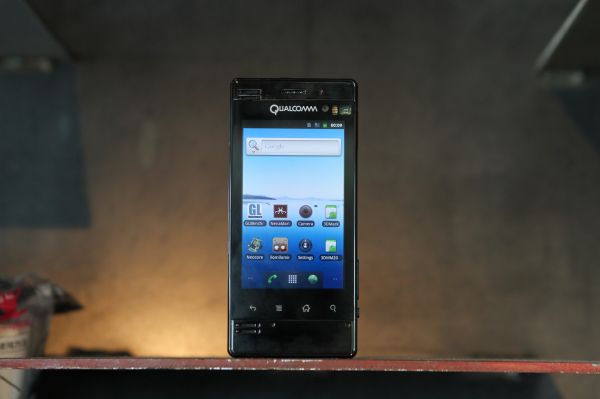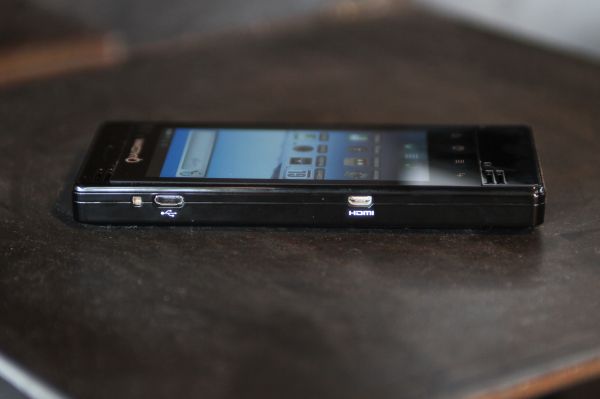Dual Core Snapdragon GPU Performance Explored - 1.5 GHz MSM8660 and Adreno 220 Benchmarks
by Brian Klug on March 30, 2011 4:29 PM EST- Posted in
- Smartphones
- Snapdragon
- Qualcomm
- Adreno
- MSM8660
- MDP
- Mobile
Way back at CES we saw our first glimpse of MSM8x60 and Qualcomm's Snapdragon Mobile Development Platform (MDP) with an MSM8660 SoC inside. Though we couldn't run any benchmarks on it, we got a sneak preview of dual core snapdragon. This year at MWC Qualcomm gave us a considerable amount of hands-on time with the same MDP hardware. We did a bit of testing, and then Qualcomm did something awesome - they let us take an MDP with the MSM8660 inside home with us.
In case you haven't been following, MSM8x60 is Qualcomm's first dual-core SoC. It's two Scorpion cores, an Adreno 220 GPU, and cellular modem all built on the 45 nm process. Like the rest of Qualcomm's lineup, the x in MSM8x60 can either be a 2, denoting GSM, UMTS, and HSPA+ support, or a 6, denoting all the same thing but with CDMA2000 and EVDO. Similarly, 9 will connote LTE support when we get to that point as well. MSM8x60 comes clocked at either 1.2 GHz or a higher 1.5 GHz. The MDP we were given was the higher 1.5 GHz variant. The MSM8x60 is the successor to MSM8x55, which is single core 1 GHz Snapdragon and Adreno 205, also built on 45 nm process.
| Qualcomm Mobile Development Platform (MDP) | |
| SoC | 1.5 GHz 45nm MSM8660 |
| CPU | Dual Core Snapdragon |
| GPU | Adreno 220 |
| RAM | (?) LPDDR2 |
| NAND | 8 GB integrated, microSD slot |
| Cameras | 13 MP Rear Facing with Autofocus and LED Flash, Front Facing (? MP) |
| Display | 3.8" WVGA LCD-TFT with Capacitive Touch |
| Battery | 3.3 Whr removable |
| OS | Android 2.3.2 (Gingerbread) |
It's been a bit busy since we got the MDP home with us, but we've run and re-run tests on the MDP all along and are ready to talk about GPU performance. The MDP we have right now is optimized for evaluating graphics performance, which we'll take a look at in this article. We'll then go into architectural changes between Adreno 200, 205, and 220, and then do the same combo of performance numbers plus architectural deep-dive with the CPU side of things in a future article.
The MDP itself is stark black and completely utilitiarian - it's a glossy, tall, extremely square package, but a smartphone nonetheless. It runs Android 2.3.2 (as an aside, isn't it ironic that prototype devices are running newer builds of Android than most smartphones you can buy retail right now) and has a number of interesting extras. There's a 13 MP rear facing camera with LED flash, front facing camera, 3.8" WVGA display, speakers, microHDMI port, microUSB, and microSD card slot. The MDP's battery is a comparatively tiny 3.3 Whr, but the entire package is totally mobile.
The one we have is again optimized for GPU testing, and sadly lacked cellular connectivity or WiFi, but gets the job done nonetheless.
The MDP's purpose is to act as a pre-commercial handset for software development rather than be something you'd ever carry around. Making reference hardware designed for developers isn't anything new in the SoC space - look no further than OMAP's Blaze platform. Qualcomm started making MDPs with the MSM8655 and sells them through bsquare, who sells them for $995. Though it isn't up yet, both these pages will soon have the MSM8660-based Mobile Development Platform.
One of the more interesting things about the MDP is that because it's a development platform, not a consumer device sold by an OEM though a carrier, it can either have Vsync enabled or disabled. This is the framerate cap we've seen on virtually every other device, which usually is right around 60 Hz. Through adb, we can turn Vsync on or off on the fly, then reboot Android's surface flinger and run tests. Sadly this procedure, while simple on the MDP, doesn't work on any other devices that aren't running Qualcomm's Android builds.
Since all of the devices we've tested thus far have been commercial, they've shipped with Vsync on and thus are limited to around 60 FPS. Thus, more than a few platforms could have had instantaneous bursts during test runs which are clipped to Vsync. To be fair to those, we've run everything on the MDP with Vsync on and off for illustrative purposes.
The MDP we tested was running all out, with maximum clocks and no power management thorottling CPU or GPU clocks down based on usage and load. As a result, testing was performed constantly plugged into a beefy USB AC power adapter. Though these benchmarks show off what MSM8660 is capable of, actual performance in shipping devices will obviously be different depending on UI, power management, and display resolution choices made by Qualcomm's OEM customers, like HTC.



















70 Comments
View All Comments
kade1878 - Saturday, April 2, 2011 - link
The iphone 4 does suck these daysSo lets compare the iPhone 4 to the Motorola Atrix 4G:
iPhone: 960x640 = 614400
Atrix: 960x540 = 518400
So the ratio is ~1.19 or the iPhone 4 has 19% more Pixels than the Atrix.
Now compare that to the Benchmark result:
iPhone: 5.9 fps x 614400 pixels/frame = 3.624.960 pixel/s or ~3.6 MPixel/s
Atrix: 18.7 fps x 518400 pixels/frame = 9.694.080 pixel/s or ~9.7 MPixel/s
Sameer254 - Sunday, April 3, 2011 - link
What's Vsync?Nick7237 - Sunday, April 3, 2011 - link
The EVO 3D will sport a 1.2GHZ version of the above chipset but still with the Adreno 220, and when your using the final product on battery it will probably peak at 34 FPS when testing with Egypt.The iPad 2 which sports the Apple A5 (Dual core 1GHZ CPU and Dual Core GPU POWER VR SGX543MP2) was getting 44 FPS without AA and 44.8 with AA on using tested with Egypt but while on battery and at a higher 1024 X 768 resolution.
Here's the link as proof: http://www.anandtech.com/show/4216/apple-ipad-2-gp...
When the iPhone 5 is released which is going to sport the A5 but at a 960 X 640 it's going to yield a 50 FPS on the final product when tested with Egypt.
Expect this years iPod touch to have the A5 as well
Being that Gameloft and EA release most of their mobile games as exclusives to iOS and that Gameloft just licensed the unreal engine for 4 upcoming games with NOVA 3 being one of them, iOS will be the king of mobile Gaming this year with this Trio of devices that will outclass the competition and yield the Best looking games once again rivaling the PS3 and 360.
When the iPhone 5 is released checkout this webiste for the benchmark results and you'll see the headline "iPhone 5 destroys the competition"
Hedgeson - Sunday, April 3, 2011 - link
What about SONY's NGP? If you're talking about mobile gaming, don't forget dedicated consoles.Quad Core Cortex A9 and Quad core SGX543MP4. Same hardware as iPad 2 and possibly iPhone 5, except for having twice the cores.
Gameloft and EPIC are already partner's of SONY for the NGPs launch.
I know this website doesn't feature gaming hardware or software, but I'm curious how the NGP would compare with phones in benchmarks.
Nick7237 - Friday, April 8, 2011 - link
I completely agree, I was salivating when I saw the NGP. To put it basically the NGP has 2 A5's inside. I must rephrase what I said now that you brought that up. The A5 will be the king of mobile gaming in smartphones and tablets this year. The NGP is a beast that I will buy from day one. They haven't even said what each core will be clocked at so realistically they could be clocked at 1.5GHZ each, which would make it better than two A5's. I think when the NGP comes out that Anandtech will definitely benchmark it and they'll state "NGP obliterates competition" especially the primitive 3DS.66699885 - Wednesday, April 27, 2011 - link
very good!kenshinhimura - Sunday, May 15, 2011 - link
PossIble to bench against samsung galaxy s2, brian?DeepDg - Tuesday, September 20, 2011 - link
How can I obtain a copy of 3Dmark Mobile 2010 for Android?rathnamachary - Monday, May 18, 2015 - link
HI All,pls help me how to run glbenchmark by remote login(i.e.. ssh), i have ran but it is giving 'xopendisplay' error.
mail id:rathnamachary@gmail.com
rathnamachary - Monday, May 18, 2015 - link
HI All,pls help me how to run glbenchmark 2.5.1 in ubuntu desktop by remote login(i.e.. ssh), i have ran but it is giving 'xopendisplay' error.